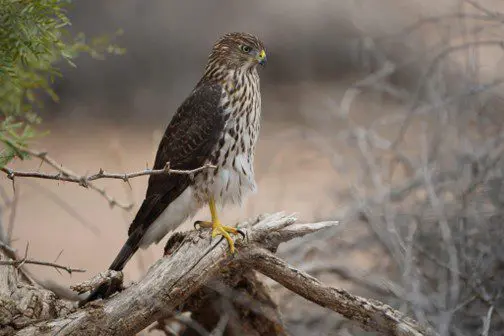The Cooper’s Hawk

Hawk (Accipiter cooperi)
WHAT WETLANDS PARK HAWK IS “VERY SCARY” TO OTHER BIRDS?
“What’s wrong with the girls?” My then office colleague and long-time friend Pam Radke was looking out the window of the first Information Center at Clark County Wetlands Park back in the 1990’s, before the existence of the state-of-the-art Nature Center came to be. Her office was at the back of the modular trailer housing the temporary exhibits and offices. The “girls” in question were the sentinel chicken flock that Clark County Vector Control (now part of the Southern Nevada Health District) kept onsite to then monitor for West Nile virus. When I looked over her shoulder, I saw that our hens were huddled in the roofed coop at the back of their very secure chain-link (fenced and roofed) yard. Once in a while, one would fearfully venture to the edge of the coop roof and peer up at the top of the modular before clucking an alarm and running back to the flock.
We snuck out the front door and around to the back and saw a big adult Cooper’s hawk (Accipiter cooperi) perched at the edge of the modular roof, his piercing raptor gaze fixed on our chubby girls. They were right to hide. Even though the fence protected them, his intentions could not have been clearer than if he was wearing a napkin tied around his neck and clutching a knife and fork in his talons – the girls were, in his opinion, lunch!
Cooper’s hawks and their very similar looking close relatives, sharp-shinned hawks, are in fact sometimes called “chicken hawks,” though chickens really are rather too large to be regular prey for either species. But there is no doubt that both are the terror of smaller birds, from pigeon size on down, often choosing to dine on mourning doves, starlings, and jays. They will often hunt near backyard bird feeders, especially in winter. Humans on “feeder watch” quickly know if hawks are in their neighborhood by the way the feeder suddenly clears and its customers scatter or freeze in place, hoping not to be noticed.
Cooper’s and sharp-shinned hawks are both uncommon medium sized hawks of forests and wooded or riparian areas, like those found in the Park’s Nature Preserve. It is often very hard to tell Cooper’s hawks from their slightly smaller sharp-shinned relatives. I have found the Peterson Reference Guide to Birding by Impression: A Different Approach to Knowing and Identifying Birds, by Kevin T. Karlson & Dale Rosselet, especially helpful in trying to solve this “hawk I.D. puzzle.”
Both species often hunt in open clearings adjacent to their woodland homes. Their relatively long tails and short, powerful wings give them great maneuverability, threading easily though tangled branches and around obstacles in pursuit of prey. With sharp eyes and ears and some luck, they may be spotted year-round.
Our photo model is a juvenile Cooper’s hawk in first-year plumage. These young birds have yellow eyes. They are dark brown above and light below, with thin brown streaks that are heaviest on the breast, and thinner on the belly. In contrast as they mature, adult birds are blue-gray above and light below with reddish-brown to orange barring and red eyes.
Watch for Cooper’s hawks (adult or juvenile) perched high in larger trees along the Park’s trails or flying overhead with a series of strong wingbeats followed by a glide. Their “flap-flap-flap-glide” flight pattern is easy to recognize!
-By Chris Leavitt, President; Facebook photo by an anonymous photographer (thank you!); pictured is a juvenile Cooper’s Hawk
Please enjoy these YouTube videos:
Cooper’s Hawk: a Reckless Predator! NARRATED Jo Alwood 3:57
Cooper’s Hawk Calls: the 3 sounds these backyard predators make ! (2024) Bird watch HQ 2:09
ID Tips: Cooper’s Hawk vs. Sharp-shinned Hawk Backyard Birding 5:51
